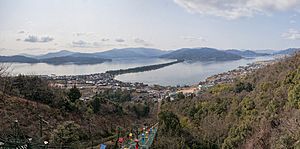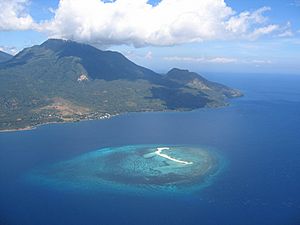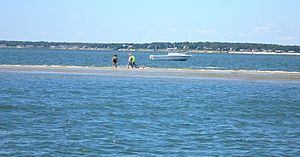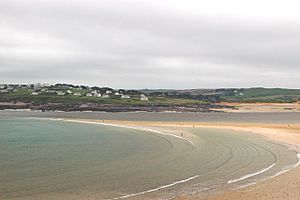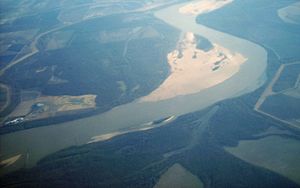Shoal facts for kids
A shoal is a natural underwater ridge or bank made of sand, gravel, or other loose material. It rises from the bottom of a body of water, like an ocean, river, or lake, almost to the surface. Shoals can be dangerous for boats and ships because they are so shallow. They are also called sandbanks or sandbars. When several shoals are connected, they form a shoal complex. Sometimes, the word "shoal" can also mean any shallow area in water, or it can describe the process of water becoming shallower.
Contents
What Are Shoals?
Shoals are usually long and narrow ridges. They form when a stream, river, or ocean current drops off sand and other small pieces of rock. This causes the water to become shallower in that spot. Shoals in the ocean can also form when barrier islands get covered by rising sea levels, or when old river deltas wear away and sink.
Shoals can be found along coastlines in the sea, where they are a type of ocean bank. They can also be found in rivers, streams, and lakes.
A shoal or sandbar can sometimes separate a smaller body of water from the sea, such as:
- Coastal lagoons (shallow bodies of water separated from the ocean by a barrier).
- Brackish water estuaries (where fresh and saltwater mix).
- River mouths and deltas that are only open to the sea during certain seasons.
The word "bar" can describe features of different sizes. They can be just a few meters long in a small stream or stretch for hundreds of kilometers along a coastline, like barrier islands.
What Are Shoals Made Of?
Shoals are usually made of sand. However, they can be made of any loose material that moving water can pick up and shift around. This includes soil, silt, gravel, cobbles, shingle, or even boulders. The size of the material depends on how strong the waves or currents are. It also depends on what materials are available for the water to move.
How Shoals Form
Wave shoaling happens when ocean waves move into shallow water, like near a beach. As they enter shallower water, they slow down, get taller, and the distance between them gets shorter. This process is called shoaling. The waves might break, depending on how big they were to start with and how steep the beach is. Waves also shoal when they pass over underwater sandbanks or reefs. This can be risky for boats and ships.
Shoaling can also make waves change direction. For example, if waves pass over a sloping underwater bank that is shallower at one end, the waves will slow down more at the shallow end. This makes the wave fronts bend, like light passing through a prism. This bending also happens when waves approach a beach at an angle.
Types of Shoals
Sandbars and Longshore Bars
Sandbars, also known as trough bars, form where waves are breaking. This is because breaking waves create a current that moves towards the shore and a balancing current that moves along the bottom. Sand carried by the offshore bottom current is dropped where the waves break. Other longshore bars can be found further offshore. These mark where even larger waves break, or where waves break at low tide.
Harbor and River Bars
A harbor or river bar is a buildup of sediment at the entrance of a harbor or river mouth. It forms from:
- Freshwater sediment being dropped off.
- The action of waves on the seafloor or nearby beaches.
If beaches are very active, or if a river carries a lot of sand and mud, a sandbar can grow big enough to completely block the river mouth. This can create a dam, causing the river to build up water. This is a natural process for water environments, forming estuaries and wetlands in the lower parts of rivers. This situation lasts until the sea erodes the bar, or the dammed river builds up enough pressure to break through it.
The formation of harbor bars can block boats and ships from entering. This can happen because of:
- Construction up the coast or near the harbor, like breakwaters (structures that protect harbors).
- Development upriver, such as dams and reservoirs, changes to riverbanks, or farming practices near rivers.
- Watershed erosion from changes to natural areas, like deforestation (cutting down forests) or wildfires.
- Harbors that were made or deepened by humans often need regular dredging (removing sediment from the bottom) to stay open.
Shoals and Boating
For boating, a "bar" is a shallow area, like a reef. It's usually a shallow formation of sand that is a danger for boats and ships, with water less than about 11 meters (36 feet) deep. It also refers to mud and sand that builds up and makes a river or creek entrance shallow. A bar can be a dangerous obstacle for shipping, stopping boats from getting into a river or harbor when the weather is bad or at certain tide levels.
Shoals as Landforms
Besides the smaller longshore bars found on beaches, the term "shoal" can also describe larger landforms that develop off a coastline due to coastal erosion. These include spits (long, narrow sand ridges extending from the coast) and baymouth bars (bars that form across the front of bays). A tombolo is a bar that connects an island or offshore rock to the mainland.
In areas where the coastline curves inward (like inlets, coves, and bays), sediments carried by a longshore current (a current that moves parallel to the shore) will drop off when the current slows down. This forms a spit. A body of water that gets cut off behind a large bar is called a lagoon. Over time, lagoons can fill up with silt and become salt marshes.
Sometimes, shoals can be the first step in the growth of beaches and sand dunes. They provide a source of sand that the wind can blow onto the shore, helping beaches and dunes grow.
Human Use of Shoals
Since ancient times, people have chosen some shoals as places to live. In early times, these spots offered easy access to ocean resources like fish and shellfish. Today, people sometimes choose these locations for their beautiful water views, but many such places are at risk of storm damage.
See also
 In Spanish: Banco de arena para niños
In Spanish: Banco de arena para niños


